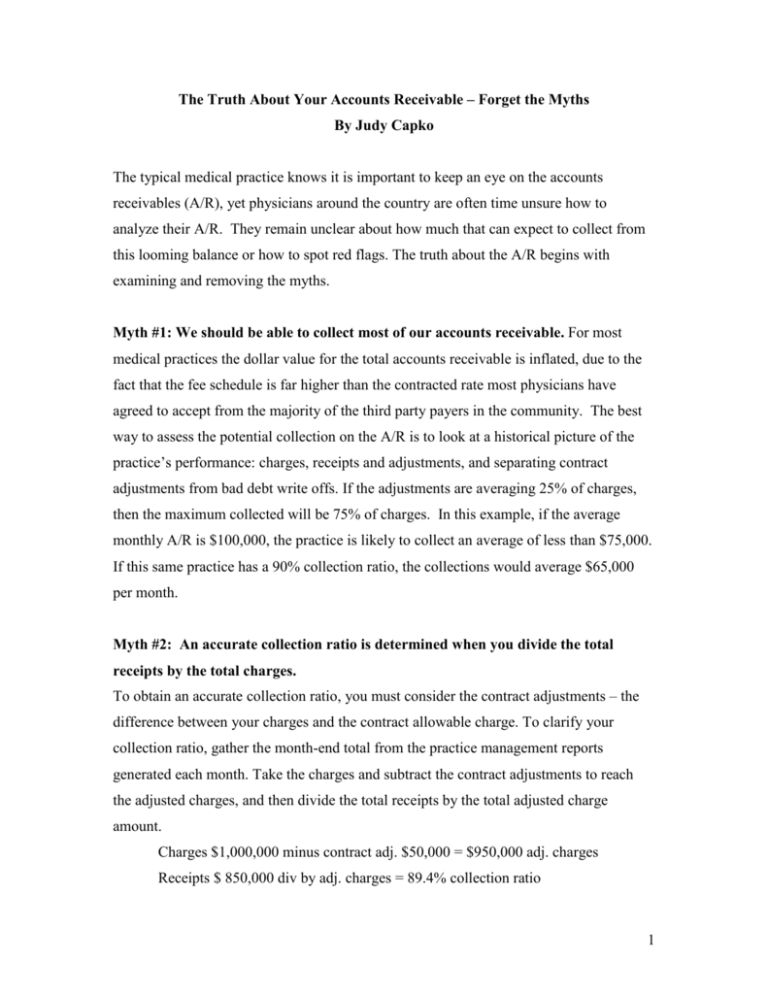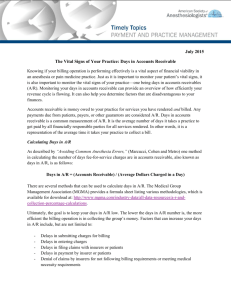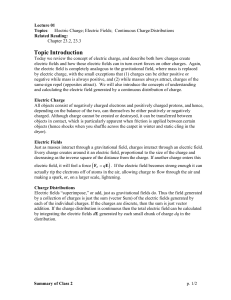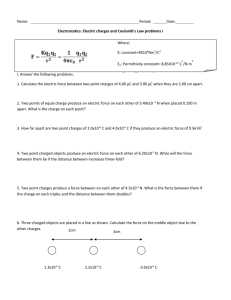The Truth About Your Accounts Receivables
advertisement

The Truth About Your Accounts Receivable – Forget the Myths By Judy Capko The typical medical practice knows it is important to keep an eye on the accounts receivables (A/R), yet physicians around the country are often time unsure how to analyze their A/R. They remain unclear about how much that can expect to collect from this looming balance or how to spot red flags. The truth about the A/R begins with examining and removing the myths. Myth #1: We should be able to collect most of our accounts receivable. For most medical practices the dollar value for the total accounts receivable is inflated, due to the fact that the fee schedule is far higher than the contracted rate most physicians have agreed to accept from the majority of the third party payers in the community. The best way to assess the potential collection on the A/R is to look at a historical picture of the practice’s performance: charges, receipts and adjustments, and separating contract adjustments from bad debt write offs. If the adjustments are averaging 25% of charges, then the maximum collected will be 75% of charges. In this example, if the average monthly A/R is $100,000, the practice is likely to collect an average of less than $75,000. If this same practice has a 90% collection ratio, the collections would average $65,000 per month. Myth #2: An accurate collection ratio is determined when you divide the total receipts by the total charges. To obtain an accurate collection ratio, you must consider the contract adjustments – the difference between your charges and the contract allowable charge. To clarify your collection ratio, gather the month-end total from the practice management reports generated each month. Take the charges and subtract the contract adjustments to reach the adjusted charges, and then divide the total receipts by the total adjusted charge amount. Charges $1,000,000 minus contract adj. $50,000 = $950,000 adj. charges Receipts $ 850,000 div by adj. charges = 89.4% collection ratio 1 By examining performance trends each month you will be able to identify when they emerge and intervene. Myth #3: A low accounts receivables total is an indicator of a well managed billing department. A low accounts receivable may give you a false sense of security. In reality, a low accounts receivable could be an indication of problems in reporting charges or making adjustments. Although the total A/R varies by specialty, the typical medical practice has an A/R that is between 1 ½ and 2 times the average monthly charges. There are a number of reasons the accounts receivable are down. If the charges are not being entered into the system, your accounts receivable will be lower. A reduced accounts receivable occurs when larger than usual, unexpected write-offs are taken. For example, if the billing department is not collecting in a timely manner, accounts begin to age, and at some point the accounts may be written off as uncollectible. It is better to be aggressive at an earlier stage. Beyond this, a sudden drop in A/R just might mean an embezzler is in your midst, pocketing payments and adjusting the account balances for the same amount. Keeping a pulse on aged A/R – the amount over 90 days is critical. A good benchmark for accounts receivable aged at 120 days or more should be no more than 15% to 20% of the total A/R. Practices should closely monitor accounts that age between 30 and 60 days, and take aggressive collection actions. If the practice does this, they are for more likely to perform within the desired benchmark. If the billing department is unsuccessful in its efforts to collect from the responsible party with 60 days, they should bring in the experts that have the skills to take effective pre-collection actions that improve your recovery rate. When a practice lets the account age beyond 120 days, unrealistic expectations emerge on accounts receivable that will yield a lower percentage return. In other words, don’t wait too long. 2 Myth #4: The insurance company knows the contracted rate and their adjudication of the claim is accurate. Insurance companies make mistakes. The problem is too few medical practices scrutinize the payment to be sure the claims were paid properly, and too often billing department staff fails to fight for what is owed. It’s your job to key your eye on the money. Monitor payment on the top 20-30 procedure codes the practice typically bills. Know what the allowable charges for the top 20 services the practice performs. Then monitor payments from the payers to be sure claims are appropriately paid. When posting the payments, don’t make adjustments on the services until you verify the payment is accurate. Myth #5: It’s reasonable to allow 45 days to receive payment on an insurance claim. Since claims are submitted electronically, it’s a matter of getting your claims in promptly and expecting the claims to be adjudicated within 30 days. In fact, if you are set up to receive electronic payment, the majority of insurance claims should be paid within 20 days. Explore the features and capabilities of your practice management system. Often there are reports that can give detailed information on claims’ status. If payments from third party payers are delayed, it may be due to claims being submitted with errors. You can also run a report on aged receivables by payer class to identify if there is one offending insurance company. Aged receivables by payer, by doctor will help you detect if one physician’s charges are not being paid. There are a number of reasons this might occur: Failure to get the physician credentialed with the particular payer Submission of inadequate documentation Inappropriate coding application Delayed charge entry and claims submission Improve your accounts receivable performance by removing the myths, examining data, maximizing the reporting capabilities of your practice management system and 3 monitoring performance over time. Beyond this, know when to bring in the big guns. Sure it makes sense to keep collections in house, but gaining the expertise of a collection agency such as Transworld Systems to conduct pre-collection activities can pay off. Keep your staff working harder on the front end; ensuring patient registrations are accurate and update, proper data entry and prompt claims submission and implementing effective in-house collections on current accounts. Working problem accounts can be time consuming for your staff and outsourcing this challenge and is often a cost effective way to stay on top of accounts receivables. Judy Capko, healthcare consultant, speaker and author of the popular book “Secrets of the Best Run Practices” She is based in Thousand Oaks, CA and is the owner of Capko & Company, www.capko.com. She can be reached at (805) 499-9203 or judy@capko.com 4







